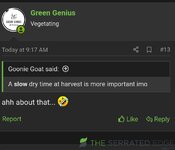Green Genius
Blooming
- User ID
- 5554
After testing and R&D on cold dry and cure fridges, talking and collaborrating with some US based sources, we have come to the acceptance that cold, low and slow is entirely incorrect for drying.
Please read the original work and we will quote highlights

 sharkmousefarms.com
sharkmousefarms.com
Please read the original work and we will quote highlights

The Science Behind Optimal Post-Harvest Practices revealed: Unveiling
The Science Behind Optimal Cannabis Cultivation revealed: Unveiling the Truth About Drying and Preservation Techniques In a groundbreaking exposé, The Deep End brings to light the hidden secrets of cannabis cultivation that could revolutionize the industry. Through meticulous research and...
 sharkmousefarms.com
sharkmousefarms.com





